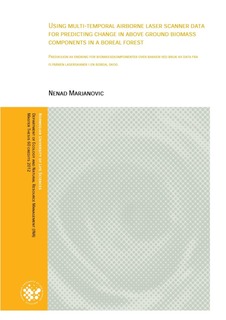| dc.contributor.author | Marjanovic, Nenad | |
| dc.date.accessioned | 2012-09-20T12:00:18Z | |
| dc.date.available | 2012-09-20T12:00:18Z | |
| dc.date.copyright | 2012 | |
| dc.date.issued | 2012-09-20 | |
| dc.identifier.uri | http://hdl.handle.net/11250/186911 | |
| dc.description | For each biomass component (stem, bark, living branches, dead branches,leaves/needles) a model of the change between two points in time were developed. The accuracy of models were tested by self validation. | no_NO |
| dc.description.abstract | Boreal forests are the main carbon sink in terrestrial ecosystems, and it account for about 90 % of the annual carbon flux between the atmosphere and the land surface. The amount of carbon that could be stored in the forest ecosystem mainly depends on the tree biomass. In order to estimate a carbon stock, it is necessary to quantify a standing woody biomass in a forest. An accurate estimation of biomass per tree components provides an opportunity for more precise carbon quantification, since the amount of stored carbon differs by the tree components. An estimation of biomass change of tree components in forest ecosystems is accordingly significant for estimation of change in the rate of carbon accumulation and carbon storage. An interest for quantification of tree biomass and its change also increased with respect to augmented use of biomass for energy production.
The aim of present study was to assess the capability of airborne laser scanning (ALS) in the detection of change in aboveground dry biomass (AGB) of different tree components. More specifically, a difference between ALS derived height and density variables observed in 1999 and 2010 has been used to model the change of AGB tree components observed at same time in the field. The height and density variables were derived from the first and last return laser echoes. A Field observed change was obtained as a difference between the AGB of tree components calculated by means of single tree biomass equations for each point in time. The data were collected from 176 sample plots in a boreal forest situated in southeastern Norway. Studied forest was actively managed and various types of changes had taken place during the eleven growth seasons. The change of total AGB during this period was ranged between -275.83 and 216.82 t/ha over sample plots, while the mean total AGB change was 19.31 t/ha. A one single model for prediction of AGB changes was developed for each of the tree component, for both unstratified (first approach) and stratified data (second approach).
The results of the presented study have shown the potential of ALS data in the detection of AGB changes from both approaches. The stratified models were more accurate and some of models explained around 90% of variation in the AGB changes. Obtained results indicated that stratification was important, but the model fit varied quite much between strata for some of the tree components. | no_NO |
| dc.language.iso | eng | no_NO |
| dc.publisher | Norwegian University of Life Sciences, Ås | |
| dc.subject | biomass estimation | no_NO |
| dc.subject | laser scanner | no_NO |
| dc.title | Using multi-temporal airborne laser scanner data for predicting change in above ground biomass components in a boreal forest | no_NO |
| dc.title.alternative | Prediksjon av endring for biomassekomponenter over bakken ved bruk av data fra flybåren laserskaner i en boreal skog | no_NO |
| dc.type | Master thesis | no_NO |
| dc.subject.nsi | VDP::Agriculture and fishery disciplines: 900 | no_NO |
| dc.source.pagenumber | 49 | no_NO |
